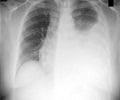An artificial intelligence (AI) system developed could help detect tuberculosis (TB) in chest X-rays at a level comparable to radiologists.

Artificial Intelligence in Diagnosing Tuberculosis
“We have effective drugs for treating TB, but large-scale screening programs to detect TB are not always feasible in low-income countries due to cost and availability of expert radiologists,” said study co-author Rory Pilgrim, B.Eng., a product manager at Google Health AI in Mountain View, California.‘Cost-effective tuberculosis screening using chest X-rays and AI has the potential to improve access to healthcare, Pilgrim said, particularly in difficult-to-reach populations.
’





“Bridging the expert shortage is where AI comes in,” said first author Sahar Kazemzadeh, B.S., software engineer at Google Health. “We can teach computers to recognize tuberculosis from X-rays so that in these low-resource settings a patient’s X-ray can be interpreted within seconds.” Kazemzadeh and colleagues developed and assessed an AI system that can quickly and automatically evaluate chest X-rays for TB. The system uses deep learning, a type of AI that can be applied to teach the computer to recognize and predict medical conditions. The researchers developed the system using data from nine countries. They then tested it on data from five countries, covering multiple high-TB-burden countries, various clinical settings and a wide range of races and ethnicities. Over 165,000 images from more than 22,000 patients were used for model development and testing.
Analysis with 14 international radiologists showed that the deep-learning method was comparable to radiologists for the determination of active TB on chest X-rays.
“We wanted to see if this system predicts TB on par with radiologists, and that’s what the study is showing,” Pilgrim said. “AI performed really well with a variety of patients.”
Trends were similar across different patient subgroups, including a test set from gold miners in South Africa, a group with a high prevalence of TB, compared to the general public.
Advertisement
Deep Learning Method to Screen Chest X-Rays
If additional research supports the results, the deep-learning system could be used to automatically screen chest X-ray results for TB. People who test positive would then receive a sputum test or nucleic acid amplification testing (NAAT). These tests are relatively expensive, but if AI could filter the patients who need the test, the benefits would be extensive. Simulations using the deep-learning system to identify likely TB positive chest X-rays for NAAT confirmation reduced the cost by 40% to 80% per positive TB patient detected.“By screening patients in the community and detecting TB before they get really sick, they could have better outcomes and may require a shorter course of treatment,” Pilgrim said. “Also, since TB is an infectious disease, if you can get to people early there will be less spread, compounding the benefits of this screening.”
Advertisement
“We hope this can be a tool used by non-expert physicians and healthcare workers to screen people en masse and get them to treatment where required without getting specialist doctors, who are in short supply,” Pilgrim said. “We believe we can do this with the people on the ground in a low-cost, high-volume way.”
Source-Eurekalert














